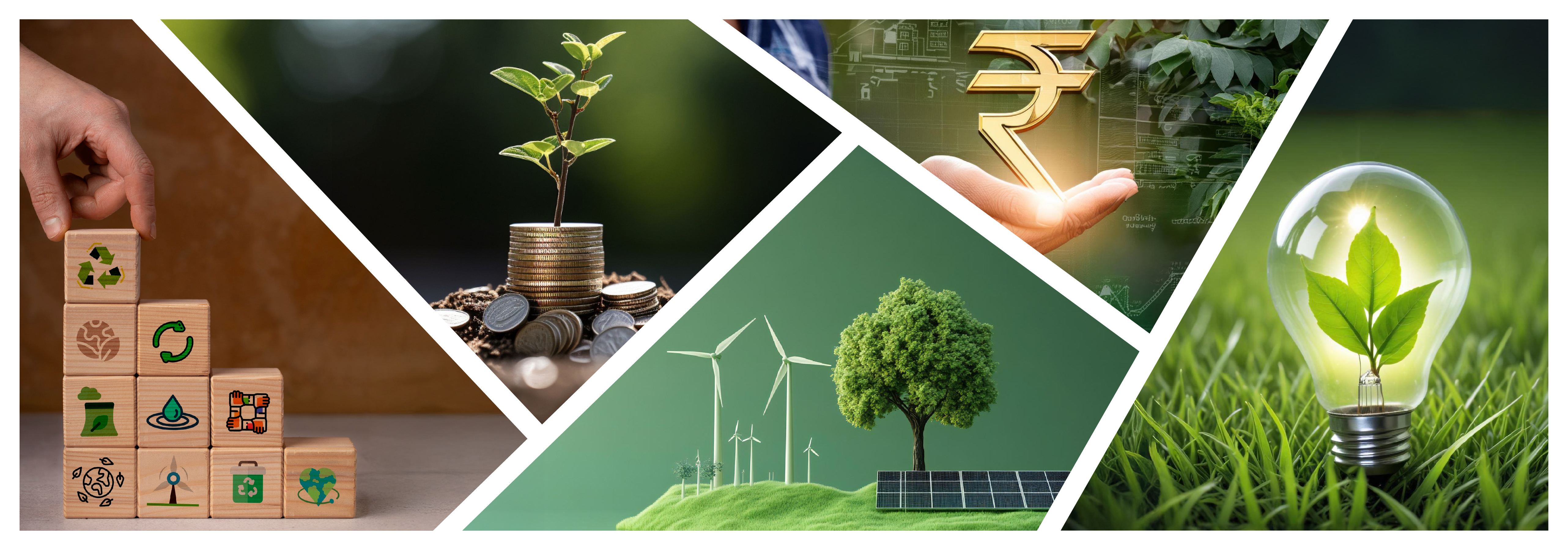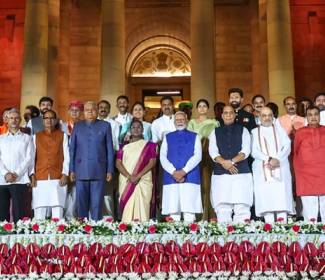India’s traditional journey is transitioning well with its ambitious sustainability goals.
On this green path, green finance and foreign investments are driving the nation toward a greener economy and have opened a vast landscape for the future.
Here, foreign investors have immense opportunities to contribute to India’s green economy, particularly in renewable energy and sustainable projects.
Foreign investment is critical to supporting India’s green ambitions at a time when government initiatives are promoting eco-friendly investments and deepening and widening the scope of opportunities ahead in India’s green economy.
Government policies supporting foreign investments
- India’s National Action Plan for Climate Change (NAPCC): This policy focuses on key aspects such as solar energy, energy efficiency, water management, sustainability, agriculture, health, the Himalayan ecosystem, sustainable habitats, Green India and strategic knowledge on climate change. In alignment with the NAPCC, 34 states and Union Territories have developed their respective State Action Plans on Climate Change.
- Green Energy Corridor: This involves developing intrastate and interstate transmission systems across multiple renewable-rich states. The seamless project ensures that the energy generated from those resources is effectively transmitted and integrated into the national grid. The process also involves setting up Renewable Energy Management Centres (REMCs) and controls infrastructure like reactive compensation, storage systems, etc.This project has been crucial in India’s energy transition, supplying electricity to ~60 Mn people through KfW-financed networks.
- National Solar Mission (NSM): Launched to promote solar energy development in India, several schemes have been introduced under this mission. These include setting up a minimum of 50 solar parks targeting 40,000 MW of solar power projects, installing grid-connected solar rooftop power plants and setting up 12,000 MW of grid-connected solar PV power projects. With India's solar power initiatives ranking fifth globally in terms of overall solar capacity, it is safe to say that the solar mission has been impactful.
- Renewable Purchase Obligation (RPO): Under this initiative, the obligated entities, majorly DISCOMs, in each state, are required to meet their minimum share — 24.3% in FY 2023 to 43.3% in FY 2030 — of electricity purchase from renewable energy, aiming to increase the share of non-fossil fuel-based power capacity to 50% by FY 2030. As a result of this initiative, solar and wind-based electricity tariffs have come down to 30% and 50%, respectively, between FY 2013 and FY 2021.
How foreign investors can contribute to India’s green goals
Supported by policy reforms, India has been reiterating its commitment to reducing carbon emissions on global platforms. Under the Paris Agreement, the country adopted the Nationally Determined Contribution (NDC) on a “best effort basis,” which includes the following targets:
- Reducing emission intensity of GDP by ~45% by FY 2030 as compared to FY 2005 levels
- Creating an additional carbon sink of ~3 Bn Tonnes of CO2 or equivalent through additional forest and tree cover by FY 2030
- Increasing the share of non-fossil fuel-based energy resources to 40% of installed electric power capacity by FY 2030
India is the fourth largest renewables producer globally with 42% of power coming from clean sources. Potential foreign investors can accelerate the development of a greener future by investing in renewable energy projects.
Pooled investment funds, sustainability-linked bonds and innovative green financing products set a bar to revolutionizse the sustainable finance landscape and provide investors with access to one of the fastest-growing global markets.
Benefits of investing in India’s renewable energy sector
India has the world’s fourth largest wind-generation capacity, with ~45 GW installed capacity, poised to increase by 60% to 71 GW by FY 2030.
As battery storage costs continue to decline, like the trend seen in solar energy a decade ago, India is all set to accelerate its storage infrastructure, potentially boosting load factors even further. This creates a compelling chance for investing in India’s growing renewable energy sector and those looking to invest here.
India is also one of the five countries globally that can produce all six major wind turbine components: nacelles, blades, towers, generators, gearboxes and bearings.
Vestas India, Suzlon Energy, ReGen Powertech, Wind World India, Orient Green Power, Indowind Energy, GE Energy India, Inox Wind, Leitwind Shriram Manufacturing, and RRB Energy are already the leading wind energy companies in India.
According to UNCTAD, developing countries like India need much larger investments to fully realise their renewable energy potential. This creates an opportunity for global investors to contribute to the nation’s energy transition, especially as the country aims to scale up its wind energy infrastructure to meet growing electricity demand while reducing carbon emissions.
According to the World Bank, keeping spaces cool using innovative energy-efficient solutions can pave the way for an investment opportunity worth $1.6 Tn by FY 2040 globally.
Apart from government agencies and domestic companies, the Asian Development Bank (ADB) and the World Bank have increased their funding. Areas include projects in green sectors in India to narrow the gap in commercial investments in renewable energy and boost various stakeholder confidence.
How sovereign green bonds attract foreign investment in India
The government issues sovereign green bonds to mobilise resources for green infrastructure facilities. The bonds are used for disbursement into public sector projects, which help reduce the economy’s carbon intensity.
The Union government issued sovereign green bonds worth approximately INR 16,000 Cr in FY 2022-23 to provide affordable funding for renewable energy projects, with a portion of the proceeds — INR 6,186 Cr — allocated specifically to renewable energy initiatives.
The government provides a low-risk investment option for foreign investors looking to contribute to sustainable projects by issuing these bonds. The proceeds from these bonds are used to fund projects that align with India’s commitment to reducing carbon emissions, thus making them an attractive option for eco-conscious investors.
Opportunities for foreign investors here
By FY 2030, India expects investment opportunities exceeding $500 Bn in sectors like renewables, green hydrogen, electric vehicles (EV) and infrastructure transition.
From April 2020 to March 2024, the total FDI equity inflow in India’s non-conventional energy sector touched more than 17 Mn.The massive push toward sustainable projects reflects India’s commitment to achieving its ambitious climate goals while fostering economic growth.
Foreign investors can tap into these opportunities by participating in various initiatives to develop renewable energy infrastructure, advance green hydrogen production, and expand the EV market.
One of the key initiatives the government has taken involves allowing foreign direct investment up to 100% through the automatic route for renewable energy projects.
The government has waived off the Inter-State Transmission System (ISTS) charges for the interstate sale of solar and wind power until June 30, next year. It has also issued orders for power to be dispatched against a letter of credit or advance payment to ensure timely payment by distributing licensees to RE generators.
The National Bioenergy Energy Programme was notified with an outlay of INR 858 Cr under the first phase to promote waste-to-energy, biomass and biogas programs.
New energy-trading platforms, specifically for the renewable energy market, — i.e., Green Term Ahead Market (GTAM) and Green Day Ahead Market (GDAM) — allow renewable developers to sell their power in the open market without getting into long-term power purchase agreements.
India is currently the only large electricity market globally that has implemented a GDAM exclusively for renewable energy.
The role of foreign investors
India requires approximately INR 20,000 Cr of annual FDI in the renewable energy segment alone. From April 2000 to March 2024, India received nearly INR 1,26,161 Cr in FDI in non-conventional energy sources.
Opportunities for collaboration are of prime importance at this hour when countries are setting up examples and goals. For instance, Britain has set a target to achieve net zero emissions by FY 2050 in which a significant increase in renewable power generation, including wind and solar, is necessary.
Green Strategic partnership with Denmark promotes political cooperation, expands economic relations and green growth, and generates employment focusing on implementing the Paris Agreement and UN Sustainable Development Goals.
Additionally, India and the EU also have forged a partnership on smart and sustainable urbanisation to build robust solid waste management systems and promote a circular economy. It aims to create smart cities with innovative housing solutions, water supply, sewage systems and more. Not just these, India has fostered similar partnerships with Austria, Germany and France, among other nations.
The innovation ecosystem — boosted by technology — in the clean energy sector is pushing boundaries with start-ups introducing scalable and sustainable solutions that help reduce carbon emissions. More than 6,600 cleantech start-ups are spread across 450 districts of India, covering nearly 34 states & UTs.
This is where India looks forward to investments worth more than INR 35 Bn per year in renewables to reach the 450 GW target by FY 2030.
Here’s where the opportunity lies for foreign investors. Their investments help bridge the funding gap needed to develop large-scale green projects.
India's green economy showcases a unique opportunity for foreign investors to leverage this space to contribute to global sustainability while gaining substantial financial benefits. The government's policies and initiatives and the country’s commitment to renewable energy projects create an inclusive environment for foreign investment.
As India continues to gradually inch toward achieving its sustainability goals, the role of foreign investors and technology is significantly enhancing the efficiency and effectiveness of these projects. These collaborations are gaining momentum as the central and state governments are facilitating the ease of doing business by making the investment areas prominent to investors and how they can further benefit from such investments.
These partnerships are big steps toward building a green economy that promises a greener tomorrow.
- https://pib.gov.in/PressReleaseIframePage.aspx?PRID=1907680#:~:text=India%27s%20National%20Action%20Plan%20for,Himalayan%20ecosystem%2C%20sustainable%20habitat%2C%20green
- https://powermin.gov.in/en/content/transmission-works-under-green-energy-corridors-i
- https://www.kfw-entwicklungsbank.de/SDG-portal/SDG-13/Green-energy-corridors-India/#:~:text=The%20results%20are%20impressive%3A%20during,to%20the%20Indian%20power%20grid.
- https://pib.gov.in/PressReleseDetailm.aspx?PRID=1983208
- https://greenly.earth/en-us/blog/company-guide/indias-national-action-plan-for-climate-change-napcc
- https://www.niti.gov.in/sites/default/files/2024-02/Policy%20Paper_Energy_12022024_V4_0.pdf
- https://energy.economictimes.indiatimes.com/news/renewable/new-renewable-purchase-obligations-why-they-are-both-difficult-and-easy/10542061
- https://dea.gov.in/sites/default/files/Framework%20for%20Sovereign%20Green%20Bonds.pdf
- https://www.ey.com/en_in/insights/climate-change-sustainability-services/how-india-can-balance-growth-and-sustainability-in-its-net-zero-journey
- https://www.morganstanley.com/ideas/india-renewable-energy-investing-opportunities
- https://www.trade.gov/country-commercial-guides/india-renewable-energy
- https://unctad.org/system/files/official-document/wir2024_en.pdf
- https://www.ey.com/en_in/insights/climate-change-sustainability-services/green-finance-is-gaining-traction-for-net-zero-transition-in-india#:~:text=Besides%20government%20agencies%20and%20domestic,the%20confidence%20of%20various%20stakeholders.
- https://dea.gov.in/sites/default/files/Framework%20for%20Sovereign%20Green%20Bonds.pdf
- https://pib.gov.in/PressReleaseIframePage.aspx?PRID=1983770#:~:text=To%20ensure%20availability%20of%20low,were%20dedicated%20for%20renewable%20energy
- https://pib.gov.in/PressReleseDetailm.aspx?PRID=2023122#:~:text=Shri%20Barthwal%20while%20addressing%20the,its%20infrastructure%20transition%2C%20by%202030
- https://dpiit.gov.in/sites/default/files/FDI_Factsheet_30May2024.pdf
- https://pib.gov.in/PressReleasePage.aspx?PRID=1885071
- https://mnre.gov.in/solar-overview/#:~:text=Government%20has%20issued%20orders%20that,Energy%20Open%20Access%20Rules%202022.
- https://mnre.gov.in/bio-energy-overview/#:~:text=Therefore%2C%20the%20Ministry%20of%20New,858%20crore%20under%20Phase%2DI.
- https://www.iexindia.com/Default.aspx
- https://www.orfonline.org/research/energy-news-monitor-volume-xix-issue-35
- https://indien.um.dk/en/denmark-in-india/green-strategic-partnership
- https://ec.europa.eu/regional_policy/policy/cooperation/international/india_en
- https://www.startupindia.gov.in/nsa2023results/sustainability-champion.html
- https://www.weforum.org/agenda/2022/07/india-investment-renewables-green-energy/






